Filter by
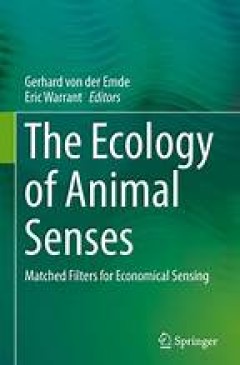
The Ecology of Animal Senses
The collection of chapters in this book present the concept of matched filters: response characteristics “matching” the characteristics of crucially important sensory inputs, which allows detection of vital sensory stimuli while sensory inputs not necessary for the survival of the animal tend to be filtered out, or sacrificed. The individual contributions discuss that the evolution of sensi…
- Edition
- 1
- ISBN/ISSN
- 978-3-319-25492-0
- Collation
- X, 269, 49 b/w illustrations, 46 illustrations in colour
- Series Title
- -
- Call Number
- -
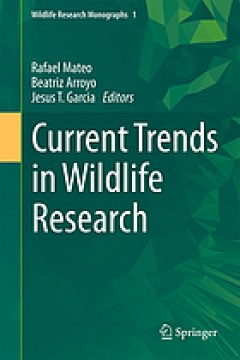
Current Trends in Wildlife Research
This book, the first in the "Wildlife Research Monograph" series, defines "wildlife research" in a variety of contexts and reviews recent research trends. The authors present the current developments they have identified using bibliometric analyses of the most common, relevant and emerging topics in wildlife research over the last three decades. Diverse aspects of wildlife research are discusse…
- Edition
- -
- ISBN/ISSN
- 9783319279121
- Collation
- x, 293 pages
- Series Title
- -
- Call Number
- 591.7

Data-driven modelling of structured populations : a practical guide to the in…
This book is a "How To" guide for modeling population dynamics using Integral Projection Models (IPM) starting from observational data. It is written by a leading research team in this area and includes code in the R language (in the text and online) to carry out all computations. The intended audience are ecologists, evolutionary biologists, and mathematical biologists interested in developing…
- Edition
- -
- ISBN/ISSN
- 9783319288932
- Collation
- xiii, 329 pages
- Series Title
- -
- Call Number
- 591.788

The Vertebrate Integument Volume 2 Structure, Design and Function
The emphasis in this volume is on the structure and functional design of the integument. The book starts with a brief introduction to some basic principles of physics (mechanics) including Newton’s Three Laws of Motion. These principles are subsequently used to interpret the problems animals encounter in motion. It is in only the last 40 or so years that we have begun to understand how imp…
- Edition
- -
- ISBN/ISSN
- 978-3-662-46005-4
- Collation
- -
- Series Title
- -
- Call Number
- -

The Tree Shrew (Tupaia belangeri chinensis) Brain in Stereotaxic Coordinates
This atlas is currently the most systematic and comprehensive atlas of the tree shrew brain. The purpose of this book is to help scientists acquire accurate coordinates of the brain regions of the tree shrew, which is becoming a popular animal model for a variety of human diseases. This atlas contains series of 192 coronal sections, 36 sagittal sections, and 49 horizontal sections using Nissl s…
- Edition
- -
- ISBN/ISSN
- 978-981-10-0611-1
- Collation
- -
- Series Title
- -
- Call Number
- -
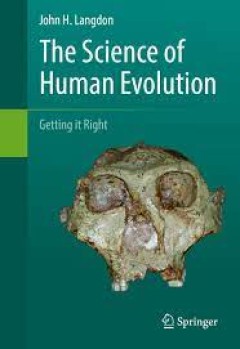
The Science of Human Evolution Getting it Right
This textbook provides a collection of case studies in paleoanthropology demonstrating the method and limitations of science. These cases introduce the reader to various problems and illustrate how they have been addressed historically. The various topics selected represent important corrections in the field, some critical breakthroughs, models of good reasoning and experimental design, and im…
- Edition
- -
- ISBN/ISSN
- 978-3-319-41585-7
- Collation
- -
- Series Title
- -
- Call Number
- -

Flight of Mammals: From Terrestrial Limbs to Wings
This book offers a new explanation for the development of flight in mammals and offers detailed morphological descriptions of mammals with flapping flight. The skeletomuscular apparatus of the shoulder girdle and forelimbs of tree shrews, flying lemurs and bats is described in detail. Special attention is paid to the recognition of peculiar features of the skeleton and joints. For the basic loc…
- Edition
- -
- ISBN/ISSN
- 978-3-319-08756-6
- Collation
- XXVII, 303 hlm.
- Series Title
- -
- Call Number
- -
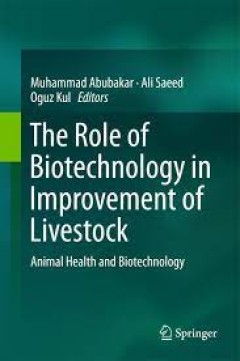
The Role of Biotechnology in Improvement of Livestock Animal Health and Biot…
This book examines how biotechnology can improve livestock breeding and farming, and thereby also animal products. In the first chapters the reader will discover which techniques and approaches are currently used to improve animal breeding, animal health and the value of animal products. Particular attention is given to reproduction techniques, animal nutrition and livestock vaccines that not o…
- Edition
- -
- ISBN/ISSN
- 978-3-662-46789-3
- Collation
- -
- Series Title
- -
- Call Number
- -

Defensive (anti-herbivory) coloration in land plants : anti-herbivory plant c…
This book presents visual plant defenses (camouflage, mimicry and aposematism via coloration, morphology and even movement) against herbivores. It is mainly an ideological monograph, a manifesto representing my current understanding on defensive plant coloration and related issues. The book is not the final word in anything, but rather the beginning of many things. It aims to establish visual a…
- Edition
- -
- ISBN/ISSN
- 9783319420967
- Collation
- xxiii, 385 pages
- Series Title
- -
- Call Number
- 591.5
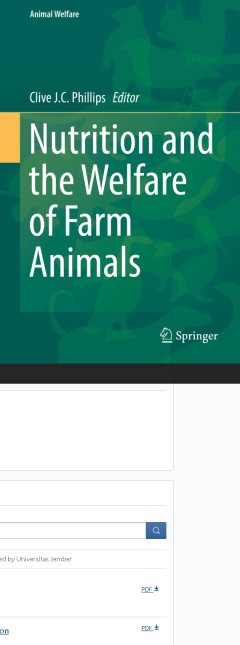
Nutrition and the Welfare of Farm Animals
This book explores the importance of good nutrition in ensuring an adequate standard of welfare for farm animals. It is often not realized that farm animals can suffer when they are fed unsuitable diets, which may be because these diets are more economic or the farmer does not know how to rectify poor nutrition. This book reveals how to recognize and deal with feeding problems in farm animals, …
- Edition
- 1
- ISBN/ISSN
- 978-3-319-27354-9
- Collation
- XXIX, 247
- Series Title
- Animal Welfare
- Call Number
- -
 Computer Science, Information & General Works
Computer Science, Information & General Works  Philosophy & Psychology
Philosophy & Psychology  Religion
Religion  Social Sciences
Social Sciences  Language
Language  Pure Science
Pure Science  Applied Sciences
Applied Sciences  Art & Recreation
Art & Recreation  Literature
Literature  History & Geography
History & Geography